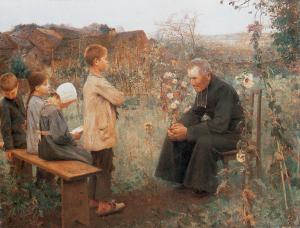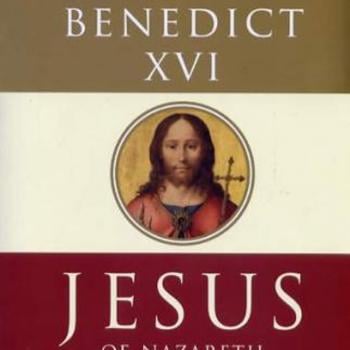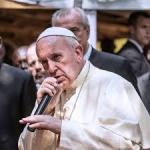There are a lot of members of the Broad Chorus of Catholic Thinkers posting articles, videos and podcasts online. So much in fact that one really doesn’t have the time, energy or computer bandwidth to read all the good things being written up and slapped on a web page. And so I decided to bring examples of a 132 of them together in one post. It consists of bits of Orthodox Catholic thoughts from the Catholic Rigorous Vortex and the Liberal Hippie Catholics and everyone else in-between.
WRN # 18 Cool Tunes From the Broad Chorus of Catholic Thinkers
Easy Access to Tunes and Tweets from the BCCT JULY 29, 2022
The diversity of thought within Catholic teaching, like variety within the strictures of sonnets, is one of its most beautiful features. It is nevertheless important to listen, as much as we can, to a broad chorus of Catholic thinkers. I have found great consolation in the fact that someone holier and smarter than myself has likely asked my questions already; my job is to find them and to listen, and then to make as many people as possible read block quotations about it.
Sharon Kabel , OSB vs. UFO: Stanley Jaki and the Theology of Aliens (June 16, 2021)- OnePeterFive
But of course with so many samples of things to look at in one semi-long post, several nifty, pithy and unique writings and more can get lost in the shuffle. So I decided to take what I gathered and break it up into smaller posts based on themes instead of particular individual Catholic websites. I even added a few other things not found in the larger collage of writings.
In this issue I present to you tunes from the BCCT on…
Theological Catechesis

Theology Online
It may be helpful here to define theology. I tend to accept St. Anselm’s broad view of theology as simply “faith seeking understanding.” By that standard, anyone who has faith and is seeking understanding is, in some fashion, a theologian. The work of good theology is ongoing, mostly hidden from the masses within the enclave of a handful of universities and institutions. Occasionally, quality theological work is published online by thoughtful writers. The problem is not that good theology doesn’t exist–it certainly does!–it is that it is completely and utterly drowned out by a deluge of hacks and amateur theologians (including myself), who believe we have a role to play in educating people about the faith, while protecting the Church against other hacks and amateur theologians. Admittedly, when I argue that my work should be allowed in the public square, it also applies to those with whom I disagree. This is certainly a Catch-22. Social media has opened up a world where bad theology spreads faster than the Church’s antiquated system of censure can respond.
Daniel Amir, The State of Social Media Theology(MAY 10, 2020) Where Peter Is
Catechesis Explained
“Catechesis is nothing other than the process of transmitting the Gospel, as the Christian community has received it, understands it, celebrates it, lives it and communicates it in many ways.” (General Directory for Catechesis #105)
This great commission has been handed to women and men, whom God has called, to proclaim the Good News. This ministry of teaching and forming has traditionally been referred to as catechesis.
The name of catechesis was given to the whole of the efforts within the Church to make disciples, to help people to believe that Jesus is the Son of God…and to educate and instruct them in this life and thus build up the Body of Christ. (Catechesi Tradendae #1)
What is Catechesis? (catholicnewsagency.com)
Theological Catechesis: Educational Topics
Both And of Catholicism
Chesterton said that Catholicism keeps its beliefs “side by side like two strong colors, red and white…It has always had a healthy hatred of pink.” What he meant was that Catholicism consistently celebrates the coming together of contraries, not in the manner of a bland compromise, but rather in such a way that the full energy of the opposing elements remains in place. And so, to give just one instance, the communion of saints, which includes the warrior Joan of Arc and the pacifist Francis of Assisi; the towering intellectual Thomas Aquinas and the barely literate Catherine of Siena; Antony, the recluse of the desert, and Thomas More, the Lord Chancellor of England, who, as Chesterton delights in recalling, wore under the splendid vestments of his office a penitential hair shirt.
The deepest ground for this uncompromising celebration of the both/and is, I would argue, the orthodox Christology of the Church. According to the Council of Chalcedon, Jesus is not partly divine and somewhat human, nor partly human and somewhat divine. Instead, he is both fully divine and fully human, each nature non-competitively present to the other in the unity of his person. Early heresies missed this both/and principle. Monophysitism hyper-stressed the Lord’s divinity, and Nestorianism hyper-stressed his humanity; and Arianism presented the apparently reasonable compromise—a blend of divinity and humanity. Yet Chalcedon, with extraordinary finesse, said no to each of these positions, and waved the flag of divinity and the flag of humanity with equal vigor.
Once you grasp this principle, you begin to see it everywhere in the great Catholic tradition. Grace and nature; faith and reason; Scripture and tradition; body and soul; God’s immanence and God’s transcendence: what the great Protestant theologian Karl Barth called “that damnable Catholic ‘and’” is what I would call its vibrant paradox.
Bishop Robert Barron, Vibrant Paradoxes: The Both/And of Catholicism (2016)
Doctrine
For better or worse, Christianity is not simply a matter of moral goodness; it is also a matter of doctrine, as it has been since the time of the Apostles. If morality is the superstructure of Christianity, doctrine is its foundation. Do away with the foundation, or simply don’t take the trouble to keep it in good repair, and the structure will collapse.
David Carlin Is Love All You Need? – (JUNE 24, 2022) The Catholic Thing
Doctrine and Development
The Catholic Church holds that our Lord Jesus Christ delivered one apostolic deposit to His apostles, and that it hasn’t changed in terms of essence or substance. The Catholic Church preserves it, and is its guardian. But there is a growth in depth of clarity, in the understanding of those truths, without essential change. Development of doctrine is the principle of a living, breathing tradition, guided by the Holy Spirit, and also the consciousness of the Church as a whole. Today’s Church shouldn’t be expected to look like the primitive Church if it is a living, vibrant, spiritual organism. But the early Church looked like a small “Catholic tree.”
Dave Armstrong, Development of Catholic Doctrine: A Primer| National Catholic Register (January 5, 2018) ncregister.com)
Church Importance
Since God chose to intervene in human affairs, writes Newman, it should not surprise us that He would “make provisions for retaining in the world a knowledge of Himself.” Left to our own devices, we would inevitably bring God’s saving message to ruin. So He established the Church and provides her the gift of infallibility, whereby, through His power, she teaches without error what God has revealed and wishes the whole world to know.
David G Bonagura, Jr. Infallibility: An Antidote to Intellectual Madness –,( JUNE 25, 2022) The Catholic Thing
History
History is the laboratory of wisdom, but the application today of the lessons learned from history is prudence.
A knowledge of Church History is a knowledge of the life of the Body of Christ extended in time throughout the past twenty centuries. It is a glorious history, with its martyrs, confessors, saints of the desert, great doctors and popes, apostles of nations, proliferation of contemplative orders, active orders, teaching orders, advances in science, medicine, the arts, missionary life, and victories over the enemies of true religion, who engaged her by pen and sword.
Without a knowledge of history, of its facts, dates, and events, a Catholic is ill-prepared to defend the Church against those who would gainsay her by misrepresentation, misinformation, or deliberate disinformation. Nor can we forget that we all have an obligation to instruct the ignorant who have been misled by error and who, in their hearts, nurture an affinity for the truth.
History – Catholicism.org
Mystery
Catholic theology distinguishes between relative and absolute mysteries of faith. A mystery is something “hidden” in the sense that we cannot understand it. A “relative” mystery is one that we human beings, in our present state, cannot understand but will be able to understand in our glorified state in heaven when we enjoy the face-to-face vision of God. An example of a relative mystery would be Jesus’ raising Lazarus from the dead (Jn 11).
An “absolute” mystery of faith is something the reality of which cannot be known before its revelation and inner possibility of which cannot positively be proved even after it has been revealed by God. There are three absolute mysteries of our Christian faith: the Holy Trinity, the Incarnation and divine grace.
FR. KENNETH BAKER, S.J., An Absolute Mystery (catholiceducation.org)
Philosophy
Catholic philosophers are uniquely situated to understand that the universe cannot make sense, human nature cannot be understood, and the meaning of human life cannot be discerned apart from a fundamental grasp of the existence and role of God, a grasp which is communicated to us through, if you will, the immensely profitable shortcut of Divine Revelation. It remains the philosopher’s role, and not the theologian’s, to thoroughly explore all human questions, to take into account the peculiar insights proper to each discipline, and to weave the whole into a comprehensive yet unified account of human nature and human life.
Dr. Jeff Mirus Why Philosophy Matters (Apr 26, 2012)| Catholic Culture
Science and Truth
Catholic thinkers from Augustine to Aquinas to John Paul II have been at pains to remind us that there are not two different kinds of truth, one for science and another for religion. But there are two kinds of questions. One sort are those that have simple and often quantifiable answers: how many, how big, what happens first, what happens next? Science answers this kind of question. Once these questions are solved, we put them aside and go on to the next set of questions.
The second kind of question, though, are those that we continue to ponder all our lives, even when we already have answers for them… questions about meaning and beauty and love. Rather than answering them, science can provoke us to ask such questions, illuminating them in a new light. When it does that, science enriches our religion and philosophy without pretending to replace it.
Br. Guy Consolmagno | A Tiny Particle of the Creator –(25 Jun 2022) Vatican Observatory
Theological Catechesis: Spiritual Topics
Angels
Men can only see in a limited spectrum of light. But some animals can see other bands of the spectrum, such as ultraviolet light. The truth of the matter is that there is far more to the universe we live in that we do not see. There is an invisible world all around us, and it is probably a mercy that God shields our vision from everything that takes place in the very room we sleep in. And even if we could see this species, I have not the faintest idea what this would resemble.
While it is true that angels only occasionally take the form of men, in their spiritual form, I cannot say what they resemble. They do not fill space the way we in the physical world do. How can something exist somewhere but nowhere? Are they phased out and at a different frequency than our reality? Are they in a dimension that is adjacent to ours, one easy for them to see beyond but impossible for us to even grasp? When it comes to the angelic species, we are animals on the ground, as to where those intelligences are like birds in the trees looking down at us and even beyond to the horizon. When we try to conceive of the angelic realm, it is as though we are trying to look at all of the fish in the daytime, and all of the refracted light from the sky blinds us to all of the fish in the water of that lake.
Laramie Hirsch Guardian Angels In An Unseen World Around You (October 2, 2018)
Angels and Demons
Conversion Awareness and Gothic Cathedrals
I can’t quite put my finger on it. When was the moment I was converted? Was it after a friend, whose virtues stood as a witness to the supernatural grace of God, unexpectedly forgave me with true Christian charity, despite all the injury I’d done him? Was it after being moved by the magnificence and soul-striking beauty of Florence and Venice, or the peaceful reverence of an Andalusian mountain town on a Sunday? Or was it rather upon the encounter with Holy Mother Church’s rich wellspring of truthful and sensical philosophy and theology?
What I do know is that, today, I’m home. More than that, it would be an insult to the graces I’ve received to pretend I’m anything less than certain about the Faith. My soul, intellect, and will have been shown more than enough for any doubts to flee.
The Catholic Faith closely reflects a great Gothic cathedral; it’s not a simple thing. And, in the same vein a great cathedral is built, none of this happened overnight.
Thomas Colsy, Discovering the Gothic foundations of Faith -(June 25, 2022) Catholic Herald
Incarnational Faith
The Catholic Faith is an incarnational Faith-i.e., the spiritual truth usually has an outward, physical manifestation. This appeal to our senses certainly is cause for joy. How often are our most joyous celebrations associated with sacraments: Baptism, the Eucharist, Matrimony. What’s more, there is a distinct, intertwined relationship between spiritual truths and physical actions. An act on earth produces an effect on the soul-the spiritual activity is represented on earth by a material sign. This multi-dimensional relationship is so filled with converse causes and effects that one hardly knows which thread to pick up first in unraveling the marvelous mysteries of the Faith!
BR. PETER JAMES, M.I.C.M., TERT. The Joy of Being Catholic – Catholicism.org
Laughter a Sign of God’s Mirth
But perhaps best of all, humor results in laughter, and laughter is an end in itself. One could borrow from Josef Pieper and say that, like contemplation, laughter’s “very premise is freedom from the fetters of workaday busyness.” We laugh, to quote the “Piano Man,” “to forget about life for a while.” In an age of never-ending darkness, we are hungry (desperate, even) for joy. Laughter is the calling card of joy. Reflexive, unbridled, unashamed joy.
Imagine the enormity of God’s mirth. Imagine the magnitude of his wit. Soon, we will know it firsthand. But in the meantime, God left us with just a taste of the awesome mirth that is to come: glorious, delicious, irrepressible laughter.
TOD WORNER The Deeper Meaning of Laughter (JUNE 16, 2022) Word on Fire
Legos and Creation
The joy of Legos is in their creative capacity. It’s not that you can build magnificent structures with them, really; it’s that you can build quite literally whatever you want. And for a child—someone with an innate capacity for worldbuilding—that’s life-changing. It’s something you can never tire of. Until you grow old, of course.
Part of what makes Legos so genius is that they echo and parody the ultimate creative process, that of the universe itself. Just as we can make anything from a set of six or so different types of blocks, God could make everything in the universe from a set of 118 elemental “blocks.” Even us. Just like Legos in the hand of a seven-year-old, we occupy, for a brief instant, a heartfelt place in the story of a creator. When we die, we too dissolve into our constituent building blocks, ready to be used again for the creator’s next project. Stephen McNulty Legos, childlike joy and God’s creativity (July 12, 2022) America Magazine
Lesser Known Judgement
Marian Devotion
Church understanding is no static thing, locked up and airless, a deposit of changeless truth that suffocates any attempt to nudge consciousness forward. If you’ve heard otherwise, consider that Mary of Nazareth lived 2,000 years ago, yet the tradition concerning her assumption was made dogmatic by Pope Pius XII in 1950. That’s a long, long time for an idea to percolate.
How did the concept of Mary’s bodily assumption into heaven wind up promoted as a teaching? You could say it was born of the love believers have always had for this exceptional woman. Motherly love runs deep in the human story, and Marian devotion is its highest expression. Visit the Holy Land today and you’ll find as many grand sites venerating Mary as those honoring her son. There’s a church dedicated to Mary’s parents, Joachim and Anne—who aren’t in the biblical record, yet our desire to know them made it essential that they emerge from history’s shadow with names and a backstory. You can visit Mary’s well in Nazareth, where her encounter with the angel Gabriel is believed to have taken place. The site honoring Mary and Elizabeth’s visitation is now visited by millions. Manger Square in Bethlehem, where Mary gave birth to the world’s hope, isn’t far from a grotto dedicated to Mary’s breast milk, where hopeful mothers leave their prayers and later mail back photos of the children that resulted. Nazareth contains a house where Mary reputedly lived with Joseph and Jesus.
How Catholics’ love for Mary shaped church teaching – U.S. Catholic (uscatholic.org)
Plants and Managing Small Sins
I brought a chocolate peppermint plant a few weeks ago. It looked strong and healthy. Suddenly Thrips (a tiny bug) attacked the plant. Thrips are deceiving because you can’t see them right away. They blend in with the color of the plant.
They remind me of the spiritual life. Sometimes sin appears small. If not treated properly, it takes over and destroys us spiritually. Confession is very important! After we confess our sins to the priest, God removes the sin from our lives. He picks off the spiritual bugs that are bugging us. Sometimes God uses plants and flowers to remind us of our spiritual lives.
Angela Lano i Lessons from a Chocolate Peppermint Plant –(June 21, 2022) The Catholic Writers Guild
Salvation by Love and Grace
Our eternal salvation is contingent upon our love, as Christ teaches. Even the baptized and believing Catholic Christian will not be saved, “who does not persevere in charity” (LG 14). If we fail to perform the “corporal works of mercy” – feeding the hungry, giving drink to the thirsty, clothing the naked, visiting the sick and imprisoned – we “will go off to eternal punishment” (Mt 25:31-46; cf. Rev 20:11-15). This is not at all contradictory to what I just said about salvation coming by God’s grace alone. For the virtues of faith and love are supernatural gifts of God; that is, they are that grace by which we are saved. God does not save us apart from ourselves: we must freely choose to cooperate with God’s saving grace (what the Orthodox call “synergy”). This is why Pius IX and Vatican II say that the non-Christian’s salvific responsiveness to God’s will occurs under the “impulse” or “efficacious power” of grace. Without this, you have the heresy of Pelagianism, which says human beings can, by their own power, obey God’s law and be saved.
Adam Rasmussen, How non-Christians can be saved(FEBRUARY 7, 2022) Where Peter Is
Scapulars
“Whosoever dies wearing this scapular shall not suffer eternal fire.”
Many of us have seen brown scapulars of Our Lady of Mount Carmel on which these words are inscribed. I have one on right now. Her feast day is tomorrow, as each year, on the sixteenth of July. Once, many years ago, an aunt of mine, who was a serious Protestant, saw these words on my scapular, and, let us say, she was not amused. (By the way, now she is dead and so she isn’t a Protestant anymore, since all the departed are Catholics by a necessary default!)
Here is the point we need to understand. Just as the Lord and his apostles give us numerous and generous assurances of salvation in the New Testament for giving a cup of cold water in his name, or for doing anything for the least of his brethren, so too these later assurances do not mean that we get to ignore or neglect the whole order of the commandments in favor of some little practice of piety. The promises attached to the wearing of the scapular, or to the recitation of the rosary or of the chaplet of Divine Mercy, are all simply the same promises that characterize the promises of the Lord in the Gospels. All these devotional practices do is make our works concrete and relate them to the mystery of the Word Made Flesh. They do not give us a pass on living an upright life in accordance with the commandments.
FR. HUGH BARBOUR, O. PRAEMIs the Scapular a Magic Charm? (• Catholic Answers .
Sexual Ethics
When you read the great evangelizing texts of the New Testament—the Gospels, the Epistles of Paul, the book of Revelation, etc.—you don’t get the impression that what their authors wanted you primarily to understand is sexual morality. Rather, they wanted you to know that the great story of Israel had come to its highpoint and that God, in the person of the crucified and risen Messiah, had come to reign as king of the world. God, redemption, the cross, the resurrection, Jesus the Lord, telling the Good News—these are the master themes of the New Testament. Again, please don’t misunderstand me: God impinges upon all aspects of life and therefore placing our sex lives under the Lordship of Jesus matters. But I fear that for so many people in the secular world today, religion is reduced to the policing of sexual behavior, and this is massively unfortunate.
Bishop Robert Barron, Dave Rubin, the “Pelvic Issues” and Larry David February 4, 2017
I believe that marriage is lifelong union between one man and one woman open to life.
Sin and What It Is
Unicorns
Another idea that came to mind was to talk about everybody’s favorite mythical mammal, the unicorn, an inoffensive subject if there ever was one, and one upon which I happen to be an expert. Not that it’s difficult to be an expert on something that does not actually exist; having a good imagination is all that’s required.
Now, as for unicorns, the subject of my expertise, it might surprise you to know that it, too, has long been a Christian symbol. Along with the pelican and the phoenix, symbols of the Precious Blood and the Resurrection respectively, the unicorn was treated in a second-century Greek patristic text called the Physiologus, where we learn that the unicorn can be captured only in the lap of a pure virgin, making it a wonderful allegory of the Incarnation of Our Lord in the virginal womb of Mary, as well as a symbol of chastity.
BROTHER ANDRÉ MARIE We Are Measured by the Quality of Our Loves – (JUN 13, 2022) Catholicism.org
What We Leave Behind
God, forgive me. In my downstairs closet I have 15 coats and eight jackets. I hate being cold. I don’t want to freeze to death. Few of these wraps are new to me, which is to say I purchased one and then another at a consignment shop, or I could not say no to a friend or sister who wanted to bestow one more upon me. It was a new color or style or length. It fit tolerably well. “Can you use it?” Yes. With each new acquisition I should be able to discard—pass along to someone else—an older outer garment. But no. I might need it someday. Duly warned—“pray that your flight may not be in winter” (Matt. 24:20)—I fear the prospect of shivering through the great Ordeal at the end of time.
Jesus says that people are known by their actions. Agreed. But there’s something more: People are known by what they leave behind.
The packaged set, boxed in flimsy poster board, captures my attention. It is, after all, a collection, handpicked reflections and directives from the reams left behind by deceased divines. Across the centuries, their texts—whether in this abbreviated format or as full tomes—found homes by the hearths of readers, some of them wrapped in winter cloaks, a shield against the cold.
I place the packet of keepsake booklets in my tote bag—a reminder to keep my collecting in line. God only knows when, but my time will come. What will I leave when I’m gone?
EVELYN BENCE What will I leave when I’m gone? (May 19, 2022) U.S. Catholic (uscatholic.org)
Other Related Posts include
Using The Kind Gaze to Look Past Splinters
The Rites of Write(ing) – A List of Catholic Authors and some of their books.
Surfing the Catholic Web
Tweeting to the Choir: A Collection of Tweets













